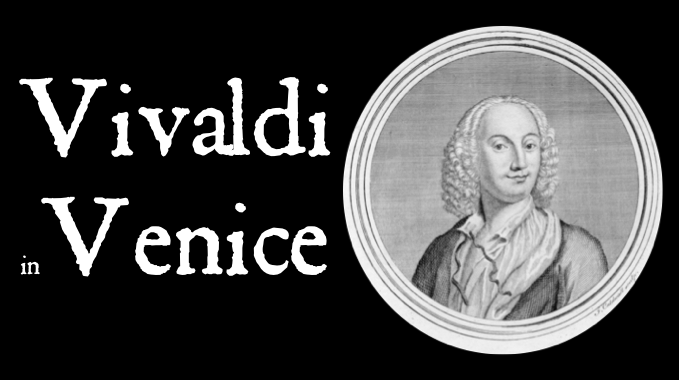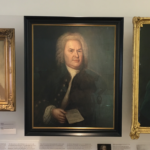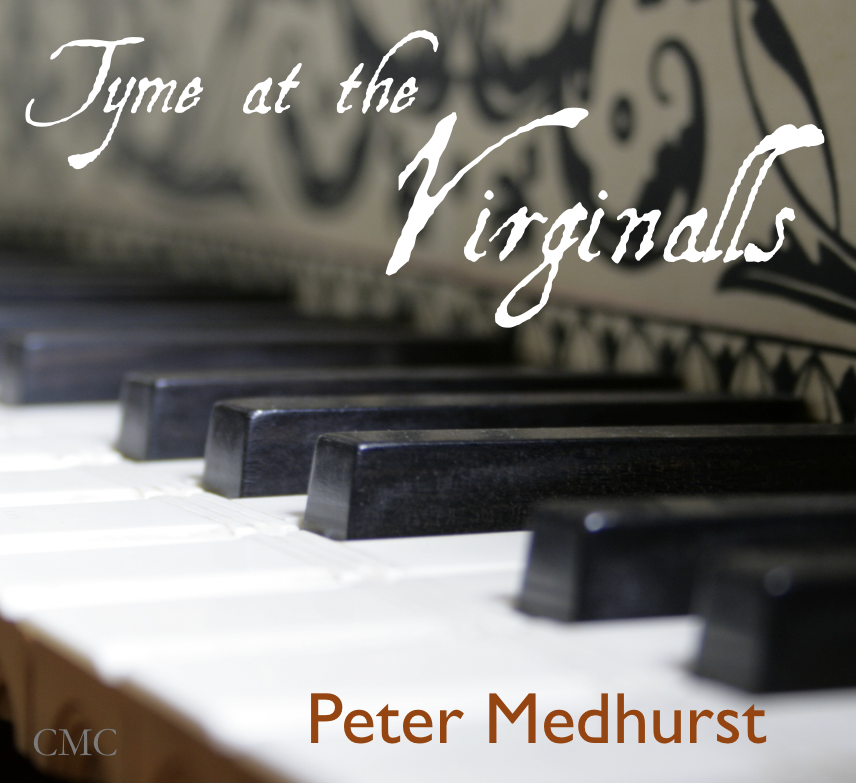 A New Lecture / Study Day
A New Lecture / Study Day
Vivaldi is the one Baroque composer whose music is a direct reflection of the city in which it was composed. Listen to a Vivaldi concerto and hey presto you are transported directly to the heart of 18th century Venice.
The reasons for this are many – Vivaldi’s passion for colour, display and spectacle in his music; the unusual way in which Venice solved its problems with the poor and the homeless; Vivaldi’s health problems and his eccentricities as a man and a priest.
Against the luxurious backdrop of 18th century Venice, and with live musical performances, this lecture (or study day) explores the amazing world of Vivaldi’s music – music that is as intrinsically Venetian as the canvasses of Canaletto.
Venice in 18th century London
A musical and artistic partnership
 As Venice declined, it produced ever fewer opportunities for high-grade lucrative employment and as a result, many of its native artists and musicians looked for work elsewhere. Some went south to Rome and Florence, some gravitated to Paris, Vienna, and even Madrid, but many – inspired by the constant procession of Englishmen on the Grand Tour – set their sights on the ever expanding English capital. Through digital images, film and live examples sung and played at the piano, Peter Medhurst explores the knock-on effect of the Venetians’ stay in 18th century London and reveals how English culture took on a discernable Venetian quality that was to be detected in its art and music for many years to come.
As Venice declined, it produced ever fewer opportunities for high-grade lucrative employment and as a result, many of its native artists and musicians looked for work elsewhere. Some went south to Rome and Florence, some gravitated to Paris, Vienna, and even Madrid, but many – inspired by the constant procession of Englishmen on the Grand Tour – set their sights on the ever expanding English capital. Through digital images, film and live examples sung and played at the piano, Peter Medhurst explores the knock-on effect of the Venetians’ stay in 18th century London and reveals how English culture took on a discernable Venetian quality that was to be detected in its art and music for many years to come.
Music performed includes: Largo from Fourth Set of Suites – Richard Jones, Allegro from Piano Sonata in C – Hook, Allegro from Voluntary in D minor – Stanley, Sonata No 3 in A minor – Galuppi, Generous and Gallant Nation – Greene
And so to Vauxhall . . . music and culture at the celebrated 18th century pleasure garden
 Although upward of a hundred pleasure gardens are known to have thrived in 18th century London, it was Vauxhall, with its walks, triumphal arches, statues and reputation for scandal, that became the firm favourite with Londoners and visitors alike. For the price of a shilling, patrons could stroll through the groves accompanied by the voices of nature, or – if they wished – could dine to the popular melodies of the day, borne high on the evening air from the famous Orchestra.
Although upward of a hundred pleasure gardens are known to have thrived in 18th century London, it was Vauxhall, with its walks, triumphal arches, statues and reputation for scandal, that became the firm favourite with Londoners and visitors alike. For the price of a shilling, patrons could stroll through the groves accompanied by the voices of nature, or – if they wished – could dine to the popular melodies of the day, borne high on the evening air from the famous Orchestra.
Drawing on period newspapers and diaries, digital images, and music in the Vauxhall Gardens’ repertoire, Peter Medhurst gives a vivid impression of cultural life at London’s first ‘South Bank’. Music performed includes: The Lass with the Delicate Air – M Arne, Blow, Blow Thou Winter Wind – TA Arne, Hornpipe for Vauxhall 1740 – GF Handel, Allegro from Organ Concerto in C – TA Arne (see recording below), Sweet Lass of Richmond Hill – J Hook, and Farewell to Vauxhall – J Lampe
TA Arne – Allegro from Organ Concerto in C written for Vauxhall Gardens – played by Peter Medhurst
________________________________________
Don Giovanni – Mozart’s Gothick opera
 Long before the famous opera appeared in 1787, Don Juan prototypes had appeared in the realms of European fact and fiction. However, it is Mozart’s Don Giovanni who has become the figurehead for all licentious lovers who meet with a sticky end. Peter Medhurst plots the history of the opera, and the progress of the Don, to reveal why it is one of the most powerful and brilliant works ever to appear on the stage.
Long before the famous opera appeared in 1787, Don Juan prototypes had appeared in the realms of European fact and fiction. However, it is Mozart’s Don Giovanni who has become the figurehead for all licentious lovers who meet with a sticky end. Peter Medhurst plots the history of the opera, and the progress of the Don, to reveal why it is one of the most powerful and brilliant works ever to appear on the stage.
Music performed may include: Theme and Variations on a melody in Don Giovanni – WA Mozart, Abendempfindung – WA Mozart, Serenade from Act II of Don Giovanni – WA Mozart, The Spirit’s Song – J Haydn, Fin ch’han dal vino from Act I of Don Giovanni – Mozart
________________________________________
The Musical World of Gainsborough & Zoffany
 The pictures of Gainsborough and Zoffany, which portray composers or musical scenes, provide a wonderful insight into the world of Georgian music making. Through Gainsborough’s great love of music I’m sick of portraits and very much wish to take my Viol da Gamba and walk off to some sweet Village when I can paint Landskips and enjoy the fag End of Life in quietness and ease, his pictures display a genius for capturing the personalities of musicians such as Johann Christian Bach, William Jackson and Johann Christian Fischer.
The pictures of Gainsborough and Zoffany, which portray composers or musical scenes, provide a wonderful insight into the world of Georgian music making. Through Gainsborough’s great love of music I’m sick of portraits and very much wish to take my Viol da Gamba and walk off to some sweet Village when I can paint Landskips and enjoy the fag End of Life in quietness and ease, his pictures display a genius for capturing the personalities of musicians such as Johann Christian Bach, William Jackson and Johann Christian Fischer.
Zoffany also had a feel for music and his canvasses depicting the Sharp family performing on the Thames, or members of the Gore family listening to a concert on a square piano, display an obvious relish for musical detail. With the help of these two great painters, the lecture looks at the lives of the Linley family, JC Bach, Abel and Mozart, to give a vivid account of one of the most engaging periods in the history of English music. Music performed may include: Sonata in D Op 5 No 2 – JC Bach, Voluntary in D minor – J Stanley, Movements from The London Notebook – WA Mozart, and When a Tender Maid is first Aswayed – T Linley Sr
________________________________________
Music on the Grand Tour
 Although a great deal has been written over the years about the Grand Tour in the 18th century, very little has been researched in the field of the music experienced by the travellers as they settled for a while in Italy (the land of music, as Francis Head once described it). For many tourists, it motivated their travels in the first instance. In 1791, for example, Thomas Brand raced through the night in order to arrive in Venice in time to hear a performance of an oratorio by Anfossi. He was not disappointed by the occasion, and later remarked I never expect so long as I live to hear such music and such execution. Although Brand was an amateur, Italy also attracted a wide range of professional musicians such as Thomas Rosingrave, the young Thomas Linley and Dr Charles Burney, who in addition to their peregrinations, learned part of their musical craft there.
Although a great deal has been written over the years about the Grand Tour in the 18th century, very little has been researched in the field of the music experienced by the travellers as they settled for a while in Italy (the land of music, as Francis Head once described it). For many tourists, it motivated their travels in the first instance. In 1791, for example, Thomas Brand raced through the night in order to arrive in Venice in time to hear a performance of an oratorio by Anfossi. He was not disappointed by the occasion, and later remarked I never expect so long as I live to hear such music and such execution. Although Brand was an amateur, Italy also attracted a wide range of professional musicians such as Thomas Rosingrave, the young Thomas Linley and Dr Charles Burney, who in addition to their peregrinations, learned part of their musical craft there.
Other visitors discovered that Italy could offer musical items of a superior quality when compared with those on offer at home; and not only did Lord Burlington return to London with a selection of Florentine and Venetian harpsichords, but with a live violinist – Pietro Castrucci – as well.
In this lecture, Peter Medhurst takes a look at 18th century Italian music making – the composers, the performers, the musical forms and styles – and determines exactly what it was that drew the musical British travellers south, time and time again.
Music performed may include: Già il sole dal Gange – A Scarlatti, Eia, Mater, fons amoris from Stabat Mater – GB Pergolesi, Dove sei from Rodelinde – GF Handel, Fugue in G – Padre Martini, Allegro from Sonata in D – D Alberti, Keyboard Sonatas K381 – D Scarlatti, as well as Scarlatti’s G major Sonata K146, which was acquired by Lord Fitzwilliam on his ‘extended’ Grand Tour when he took in Madrid. The version of this Sonata in the Fitzwilliam Museum in Cambridge (example may be heard below) and another he found, still remains the only source for the work.
Domenico Scarlatti – Sonata in G, K146 (Fitzwilliam) – played by Peter Medhurst
________________________________________
Mozart & his Portraits
 Essentially, the story of Mozart’s portraits is the story of Mozart’s life, and by a stroke of good fortune, the likenesses stretch evenly across his working career. We know what he looked like at the age of six when he charmed Maria Theresa with his tricks on the keyboard. We know that when he appeared to the Parisian audiences in 1763, he was so small in stature that when seated at the harpsichord, his feet were unable to reach the floor.
Essentially, the story of Mozart’s portraits is the story of Mozart’s life, and by a stroke of good fortune, the likenesses stretch evenly across his working career. We know what he looked like at the age of six when he charmed Maria Theresa with his tricks on the keyboard. We know that when he appeared to the Parisian audiences in 1763, he was so small in stature that when seated at the harpsichord, his feet were unable to reach the floor.
We sense a good deal of family pride in the ‘Order of the Golden Spur’ picture (Mozart was knighted by the Pope for services to Catholic music) and we have an overwhelming feel for the final stages of his genius through the sensitive, although incomplete, Lange portrait of c1790.
The lecture will show in chronological order all the surviving authentic images of Mozart, and will at the same time plot his life’s story. The presentation will also be illustrated with a selection of Mozart’s songs, arias and keyboard music.
Mozart – Fantasia in D minor K 397 for Piano – played by Peter Medhurst
________________________________________
Phantasmagoria – Gothick in the British Arts 1750~1850
17th and 18th century Europe was dominated by the intellectual movement known as the Enlightenment, where the accent of philosophical thought was focused on reason and rationalism. Naturally, the arts were influenced by this  way of thinking, and reflected preoccupations with order, balance, and form.
way of thinking, and reflected preoccupations with order, balance, and form.
However, by the mid 18th century, a surprising, and unexpected twist occurred in European culture. With Classicism at its height, there emerged a fascination for the Gothic architectural style of the Middle Ages, and within moments the other arts, from literature to music, were flirting with the knock-on effects of horror, mystery, and the supernatural.
The Gothic Revival had its fullest expression in Britain (where the original Gothic style had never entirely died out) and it is the artistic products of the genre, that become the themes for this lecture – Phantasmagoria – a display of fantastic images.
Music includes: The Spirit’s Song – J Haydn, Arias from The Haunted Tower – S Storace, The Curfew Tolls the Knell of Parting Day – S Storace, Awake! My Lyre – T Linley Jr, First movement from Symphony No 3 The Scottish – F Mendelssohn




![The Scotish [sic] Gigg](https://petermedhurst.com/wp-content/uploads/2012/08/Peter120813untitled-shoot-2.jpg)